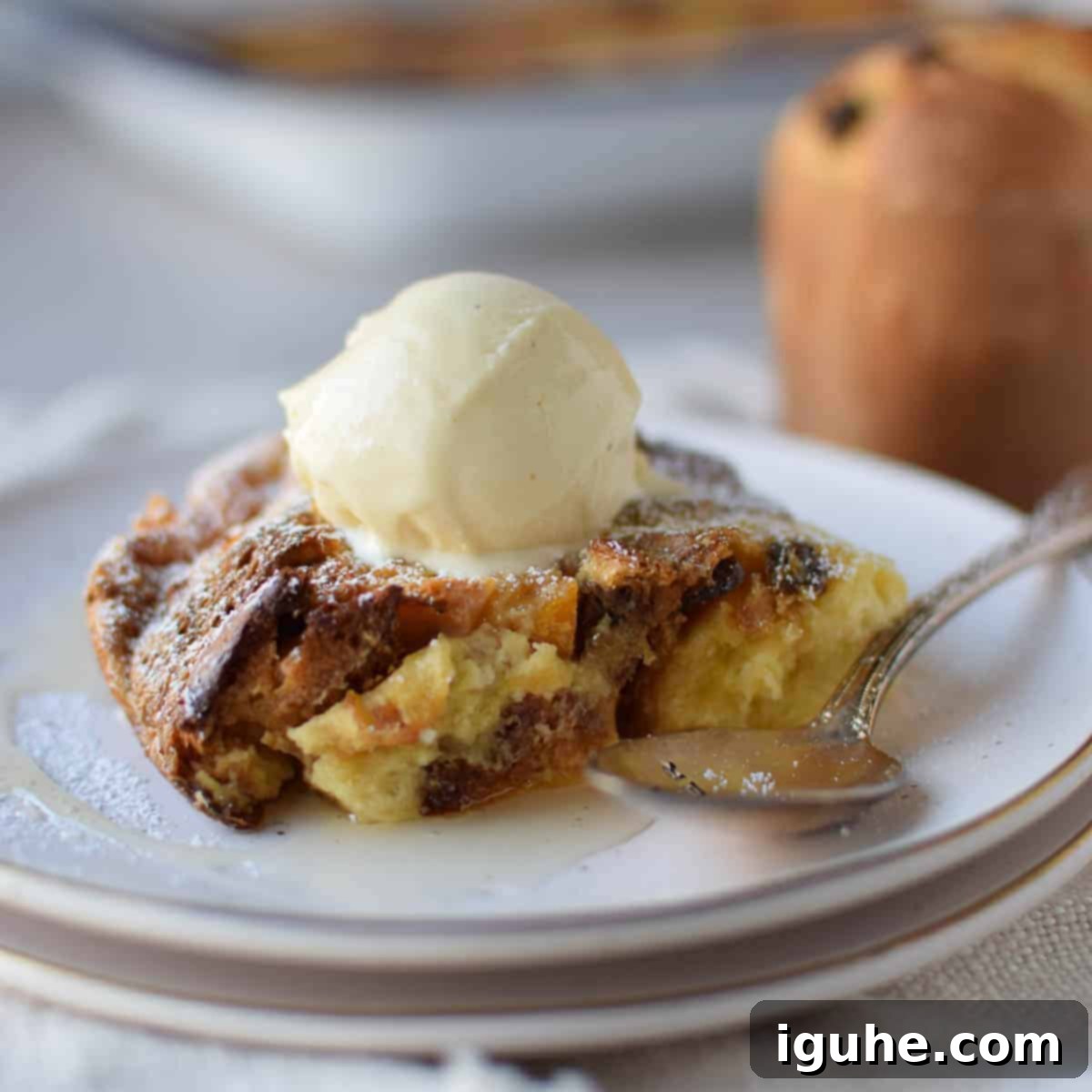Decadent Panettone Bread Pudding: A Beloved Italian Christmas Dessert Reinvented
For those of Italian heritage, the sweet, fragrant essence of panettone is practically embedded in their culinary DNA. And if you’re not Italian, you’ve undoubtedly encountered this iconic fruity sweet bread gracing store shelves and holiday tables everywhere as Christmas approaches. While delicious on its own, a truly remarkable way to transform this traditional festive cake into an even more indulgent treat is by crafting a rich and comforting **Italian Bread Pudding with Panettone**.
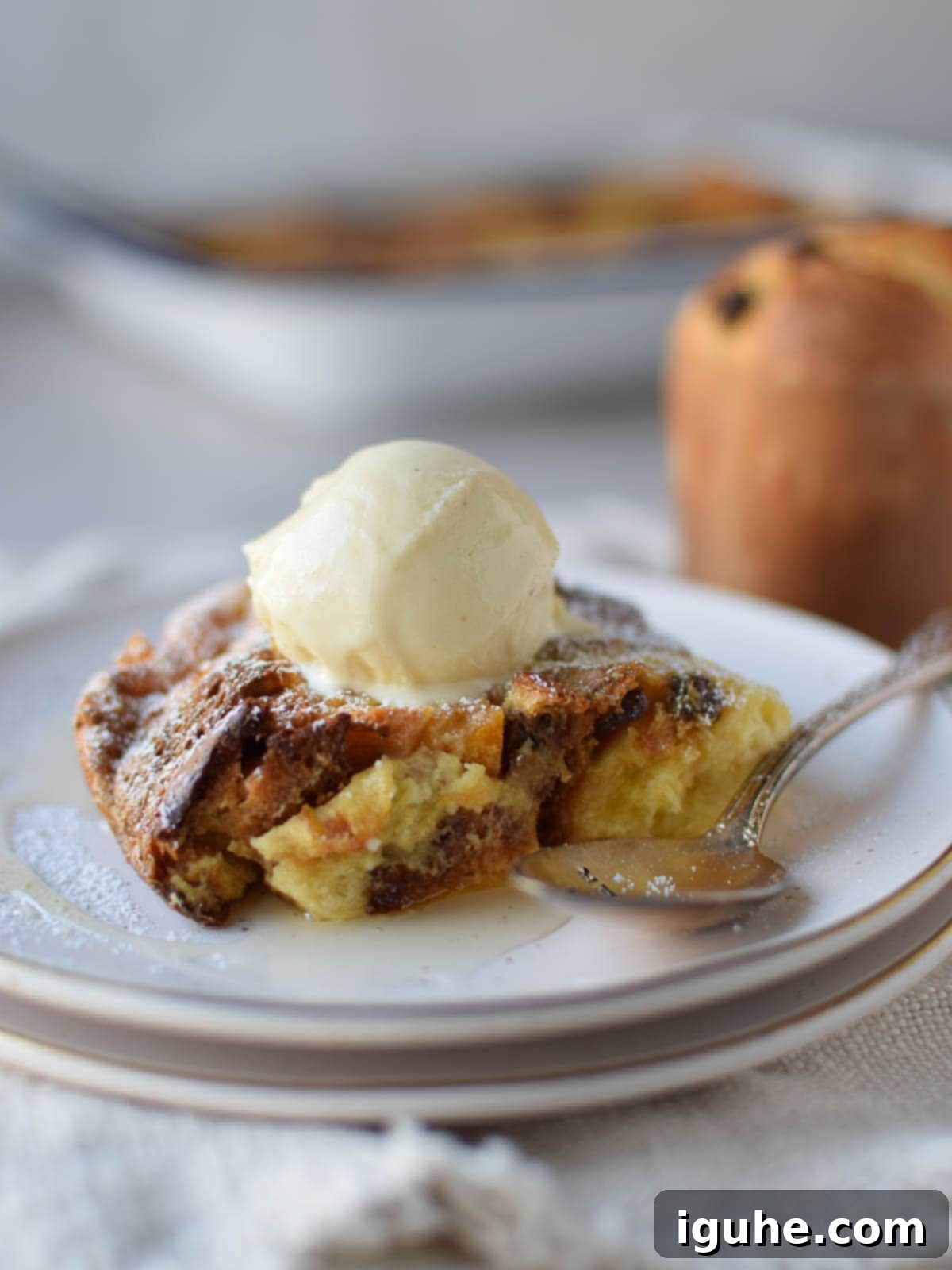
Confession time: I wasn’t always a fan of panettone. Growing up, my nonni (grandparents) always had it in the house, often with the casual remark, “It never goes bad.” This endless shelf life, while practical, initially made me a little skeptical. Once you get past the initial thought that this sweet bread could potentially outlast a zombie apocalypse (it truly can’t, but let’s appreciate its longevity!), you begin to unlock its astonishing versatility and endless culinary possibilities. It’s a canvas for creativity, especially when you consider its inherent flavors.
The beauty of using panettone in bread pudding lies in its rich, pre-existing flavor profile. Unlike plain bread, panettone comes generously studded with a delightful assortment of candied fruits, aromatic raisins, and often a hint of citrus and liqueur. This means half the work of infusing flavor is already done for you! All you need to do is prepare a luxurious custard base to bind it all together. To truly elevate and harmonize with the candied fruits and subtle brandy notes often found in panettone, I enhance my custard with fresh orange zest and a touch of orange liqueur, adding layers of bright, warm flavor that truly make this dessert sing.
This Panettone bread pudding has become a cherished tradition in my home, particularly as a New Year’s treat. It disappears remarkably fast, even converting previous “panettone haters” into devoted fans. Its rich, moist texture and vibrant flavors are simply irresistible. While it makes for an incredibly decadent dessert, don’t limit yourself – it’s equally fantastic served warm as a special breakfast or brunch item, perhaps with a dollop of yogurt or a drizzle of maple syrup. It’s truly a flexible recipe that brings joy any time of day, especially during the festive season.
What is Panettone? Unpacking This Italian Holiday Staple
Panettone is far more than just a sweet bread; it’s a culinary icon, deeply woven into Italian Christmas and New Year traditions. Originating from Milan, this unique Italian yeast-leavened bread is renowned for its distinctive tall, dome shape and light, airy texture. Traditionally, classic panettone is generously studded with an abundance of juicy raisins, vibrant candied orange and lemon peels, and sometimes a hint of aromatic liqueur. The production process for authentic panettone is quite elaborate, often involving a long, slow leavening period (sometimes taking days) with a mother yeast, and using high-quality ingredients like butter, eggs, and sugar to achieve its characteristic rich flavor and delicate texture.
While the traditional version remains a timeless favorite, modern panettone varieties have exploded in popularity, offering exciting twists on the classic. You can now find gourmet panettones featuring rich chocolate chips, zesty lemon cream fillings, luscious pistachio cream, or even inspired by other Italian desserts like tiramisu. These contemporary variations often come in beautifully adorned packaging, making them exquisite gifts and impressive additions to any holiday spread.
During the festive season, panettone becomes ubiquitous. While specialty Italian food stores are a reliable source for high-quality, artisanal options, you’ll also find a wide array of brands in major retail chains, from gourmet grocery stores to department stores like TJ Maxx and Target, and even local pharmacies. This widespread availability means that enjoying this holiday delight has never been easier. By itself, a slice of panettone makes a wonderful accompaniment to your morning coffee or tea. It’s also incredibly versatile in other recipes; for instance, stale panettone transforms beautifully into a luxurious panettone French toast, providing a delightful breakfast experience.
Key Ingredients for a Perfect Panettone Bread Pudding
Creating this irresistible Italian bread pudding requires just a handful of straightforward ingredients, primarily leveraging the inherent goodness of the panettone itself. Here’s a closer look at what you’ll need to gather:
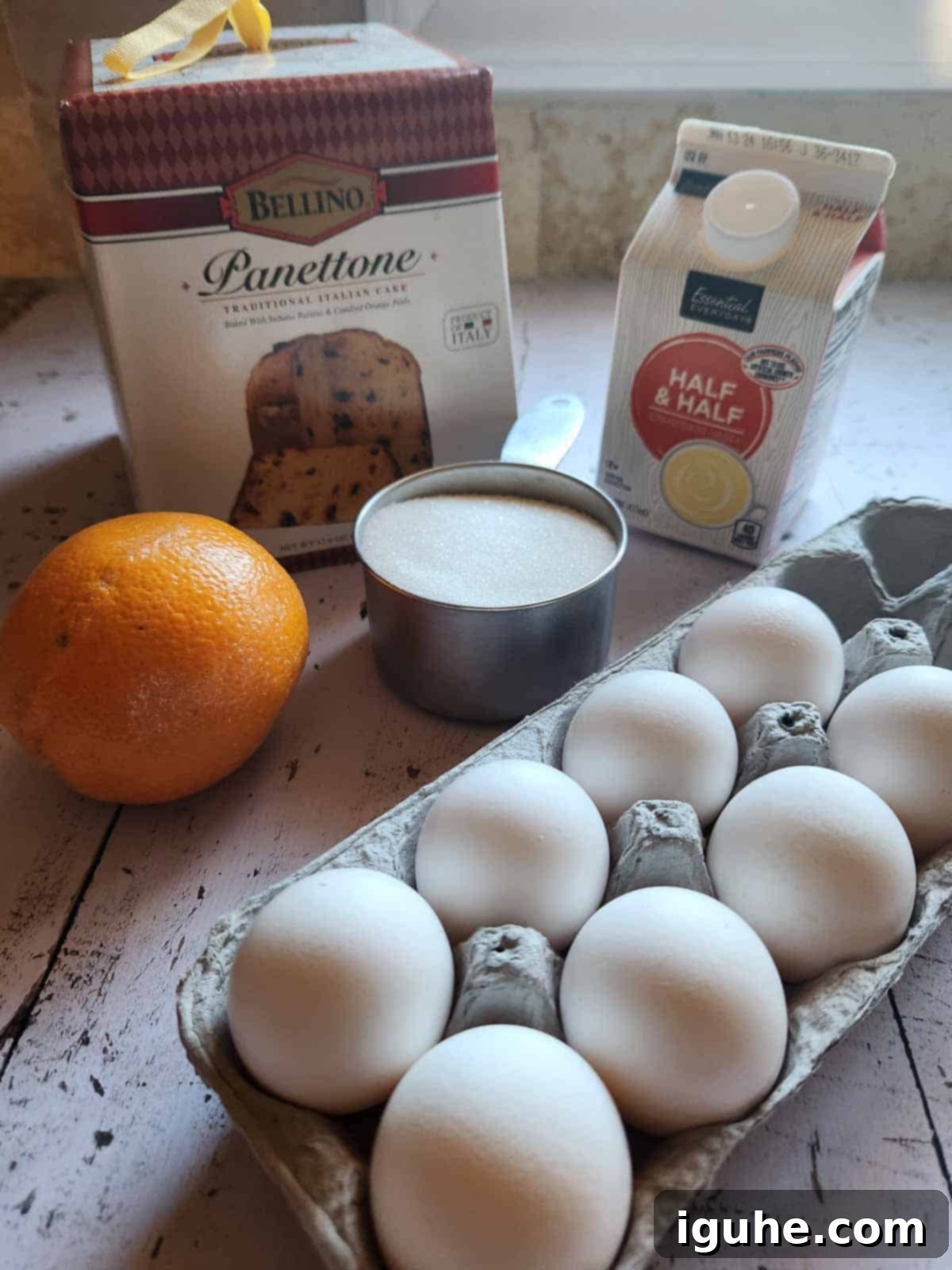
- Panettone: The star of our show! I personally gravitate towards the classic variety, brimming with candied fruit and raisins, as its traditional flavors really shine through. However, feel free to experiment with other flavored panettones like chocolate, pistachio, or almond – they would introduce wonderful new dimensions to the pudding. You’ll need about one pound (approximately 17.6 ounces). If you happen to find a two-pound loaf, simply use half for a single batch or double the custard recipe to create an extra-large, crowd-pleasing dessert. Don’t worry if your panettone is slightly over one pound; using the entire amount will only make the pudding richer and more substantial. Any leftovers can be repurposed into delicious panettone French toast, ensuring no crumb goes to waste!
- Whole Milk and Heavy Cream: This combination forms the creamy, luscious base of our custard. While you could use whole half-and-half as a convenient alternative, I strongly recommend sticking to full-fat dairy options. The higher fat content contributes significantly to the richness and silky texture that defines a truly exceptional bread pudding, preventing a watery or thin result.
- Eggs: Essential for creating that signature custardy texture. Along with the milk and cream, the eggs act as a binder, setting the pudding beautifully as it bakes and giving it a delightful firmness while maintaining a delicate interior. Use large eggs for consistency.
- Sugar: White granulated sugar is perfect here. Remember that panettone is already quite sweet, so the sugar in the custard is primarily to enhance the overall sweetness and balance the richness of the other ingredients, not to overpower the delicate flavors of the bread.
- Orange Zest: This ingredient is key to brightening the flavors. The aromatic oils from fresh orange zest work wonders in complementing and enhancing the candied orange peel and other citrus notes already present in the panettone, creating a harmonious and vibrant taste profile.
- Orange Liqueur: (Optional but highly recommended) I often have Grand Marnier, an exquisite orange-flavored cognac, on hand for desserts, and it’s a perfect match here. Its complex, slightly bitter orange notes and brandy undertones beautifully echo the traditional brandy essence often found in high-quality panettones, adding a sophisticated depth to the pudding. If you prefer to omit alcohol, simply increase the orange zest or add a splash of orange juice for similar brightness.
- Sliced Almonds: (Optional) I sometimes enjoy a subtle crunch and elegant presentation, and a sprinkle of sliced almonds can provide just that. They add a lovely textural contrast to the soft bread pudding and toast beautifully during baking. However, I often omit them for a simpler, smoother pudding. If you’re looking to impress guests, a light sprinkle of almonds provides a refined finishing touch.
Refer to the detailed recipe card below for the precise measurements and a complete list of ingredients.
Step-by-Step Instructions for Your Delicious Panettone Bread Pudding
Making this Italian Panettone Bread Pudding is a straightforward and rewarding process. Follow these simple steps for a truly memorable dessert (or breakfast!).
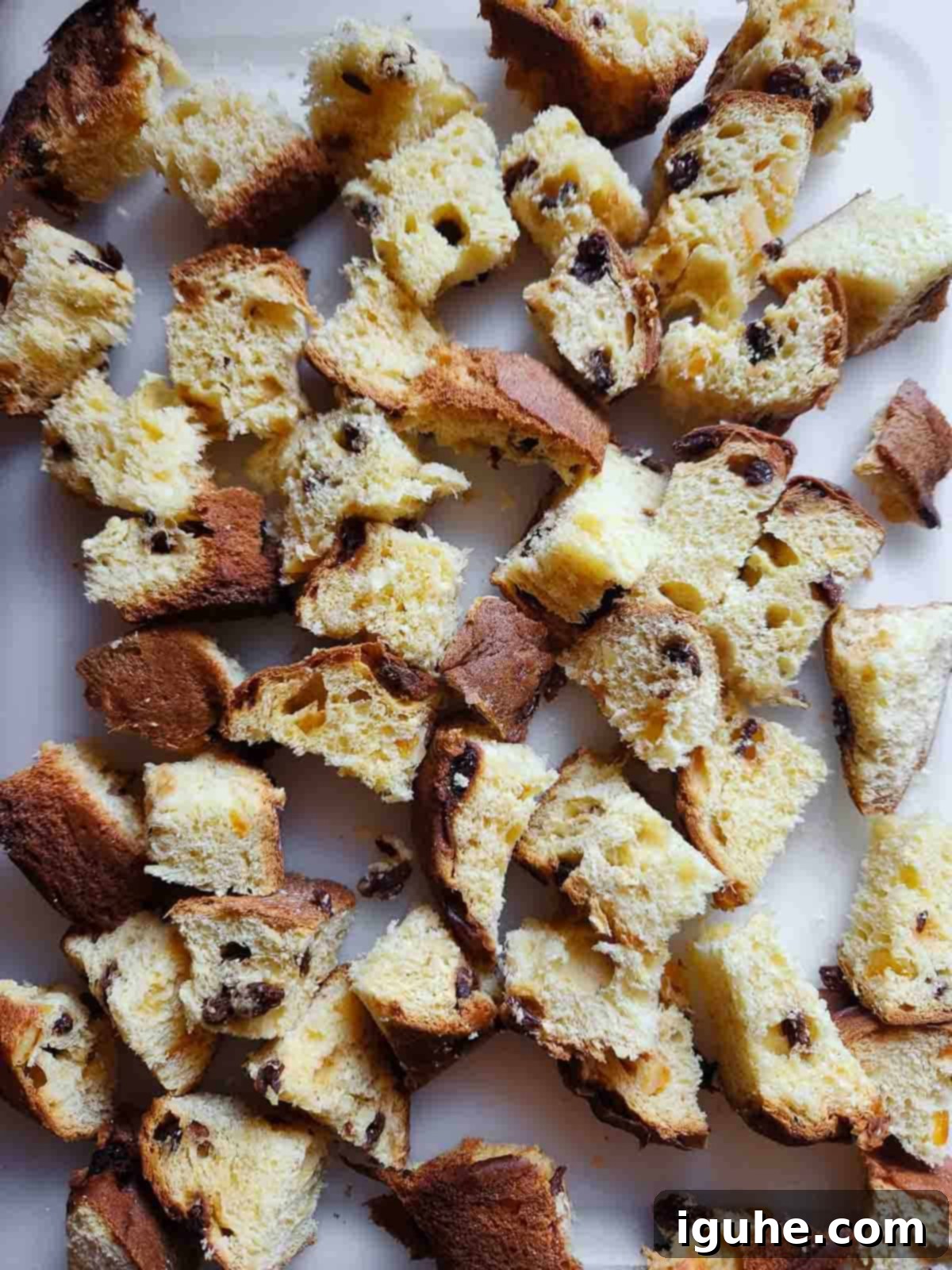
Begin by carefully removing the panettone from its packaging. Using a sharp knife, cut the panettone into roughly 1 to 1.5-inch pieces. Don’t worry about perfect uniformity; slightly irregular chunks will add a wonderful rustic charm and varied texture to the finished pudding. If you prefer a chunkier bread pudding, feel free to cut them even larger. Importantly, do not trim the crusts; they contribute flavor and structure. At this stage, you have a couple of options: you can either leave the panettone cubes out at room temperature for at least 6 hours, or even overnight, to allow them to become slightly stale (this helps them absorb the custard better without becoming soggy), or you can quickly toast them in a 350℉ (175°C) oven for about 10 minutes until lightly golden and firm. This toasting method is a great time-saver.
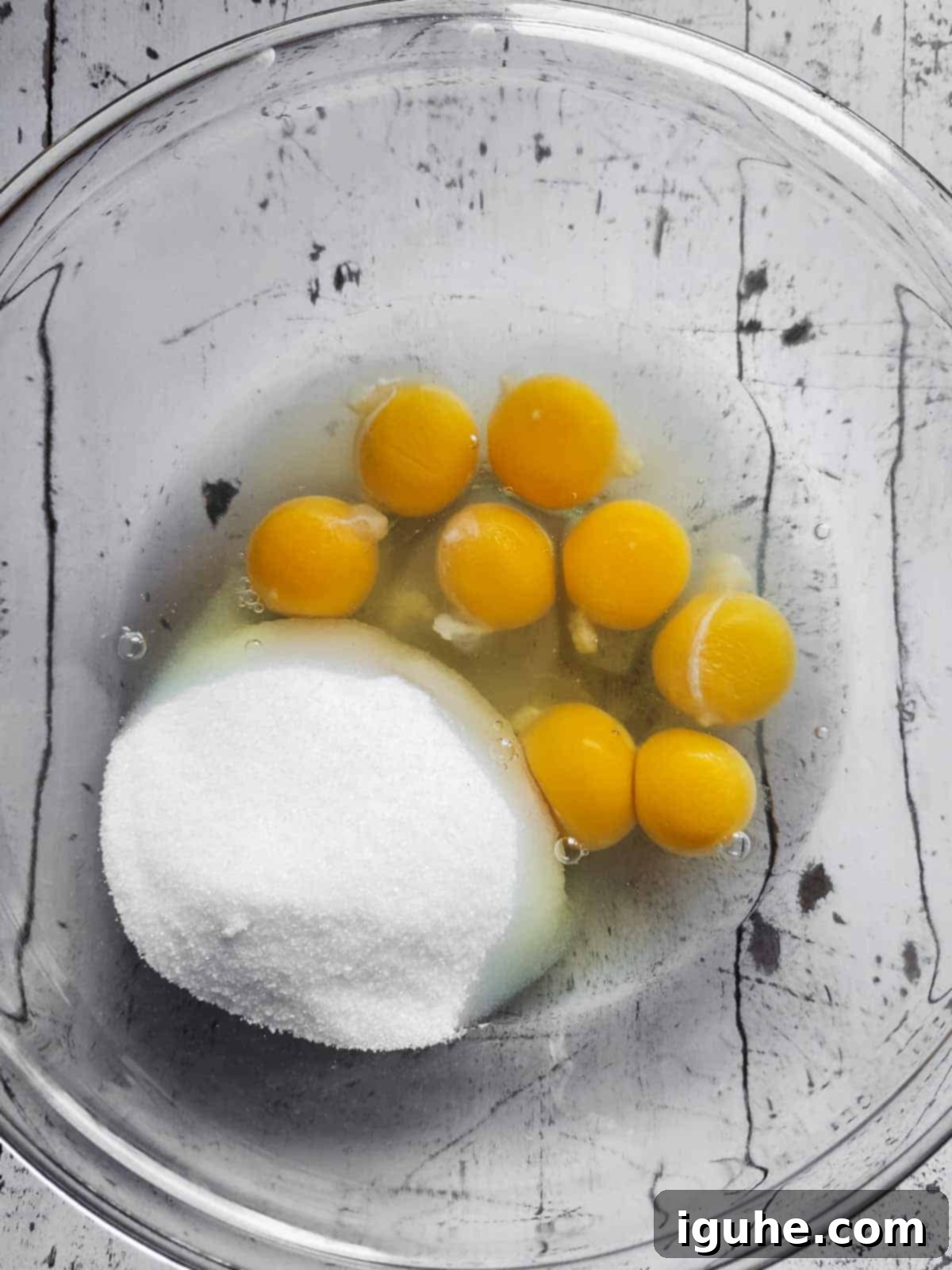
While your panettone prepares, move on to the custard. In a large mixing bowl, crack the eggs and add the granulated sugar. Whisk these two ingredients together vigorously until they are well combined and the sugar has largely dissolved. The mixture should become pale yellow and slightly frothy, indicating a good incorporation of air. This initial whisking ensures a smooth and evenly sweetened custard.
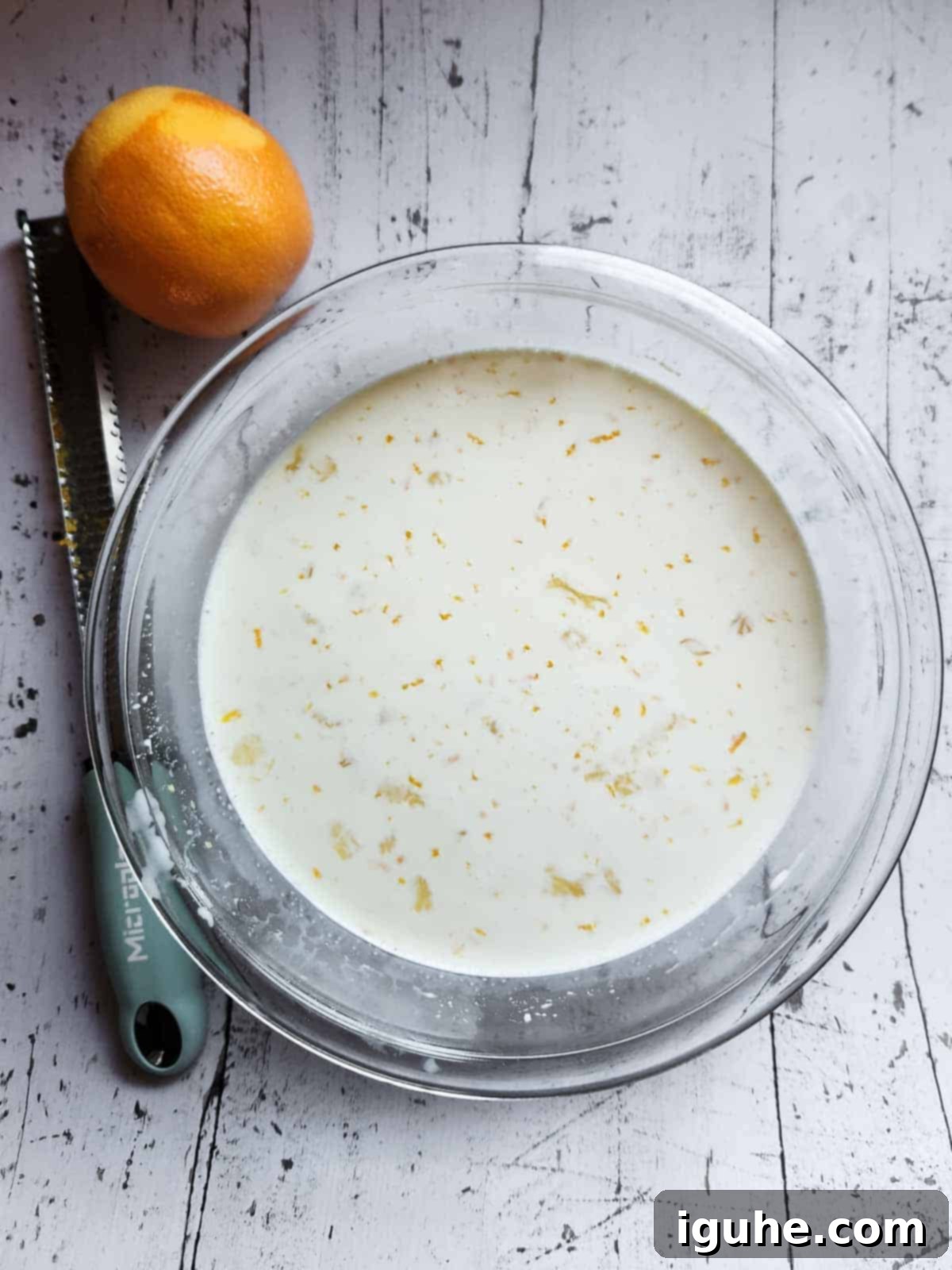
Next, pour in the whole milk and heavy cream (or half-and-half if you’re using that instead). Add the fresh orange zest and, if you’re choosing to include it, the orange liqueur. Continue to whisk all these ingredients thoroughly until they are completely combined and the mixture is smooth and homogeneous. This ensures that every element of flavor is evenly distributed throughout the custard, which will later permeate every piece of panettone.

Now, prepare your baking dish. Lightly grease a 9×13-inch baking pan with butter, ensuring the bottom and sides are well coated to prevent sticking. Arrange the cut panettone pieces evenly in the prepared pan. Once distributed, pour the prepared egg and cream mixture slowly over the panettone cubes, making sure all pieces are coated. Using the back of a spoon or your hands, gently press down on the panettone to help it absorb the custard. Let the panettone soak in the custard for at least 10 minutes at room temperature. This crucial step allows the bread to fully imbibe the liquid, resulting in a moist and tender pudding, rather than dry spots.
Once thoroughly soaked, your bread pudding is ready for the oven! Preheat your oven to 350℉ (175°C). Carefully place the baking pan into the preheated oven and bake for approximately 45-55 minutes. The pudding is done when the top is beautifully golden brown, visibly puffed up, and the center appears set (a skewer inserted into the center should come out mostly clean, though a little moist is fine). Keep in mind that it will slightly deflate as it cools. Allow the bread pudding to cool for a few minutes before serving warm, or enjoy it at room temperature. The aroma alone will be enough to entice everyone to the kitchen!
For a complete, step-by-step guide with ingredient quantities, please refer to the detailed recipe card below.
Creative Ways to Serve Your Panettone Bread Pudding
One of the many delights of Italian bread pudding with panettone is its versatility in serving. Whether you prefer it warm, chilled, or at room temperature, there are numerous ways to enhance its appeal and turn it into an even more unforgettable treat. Here are some delightful suggestions to elevate your panettone bread pudding experience:
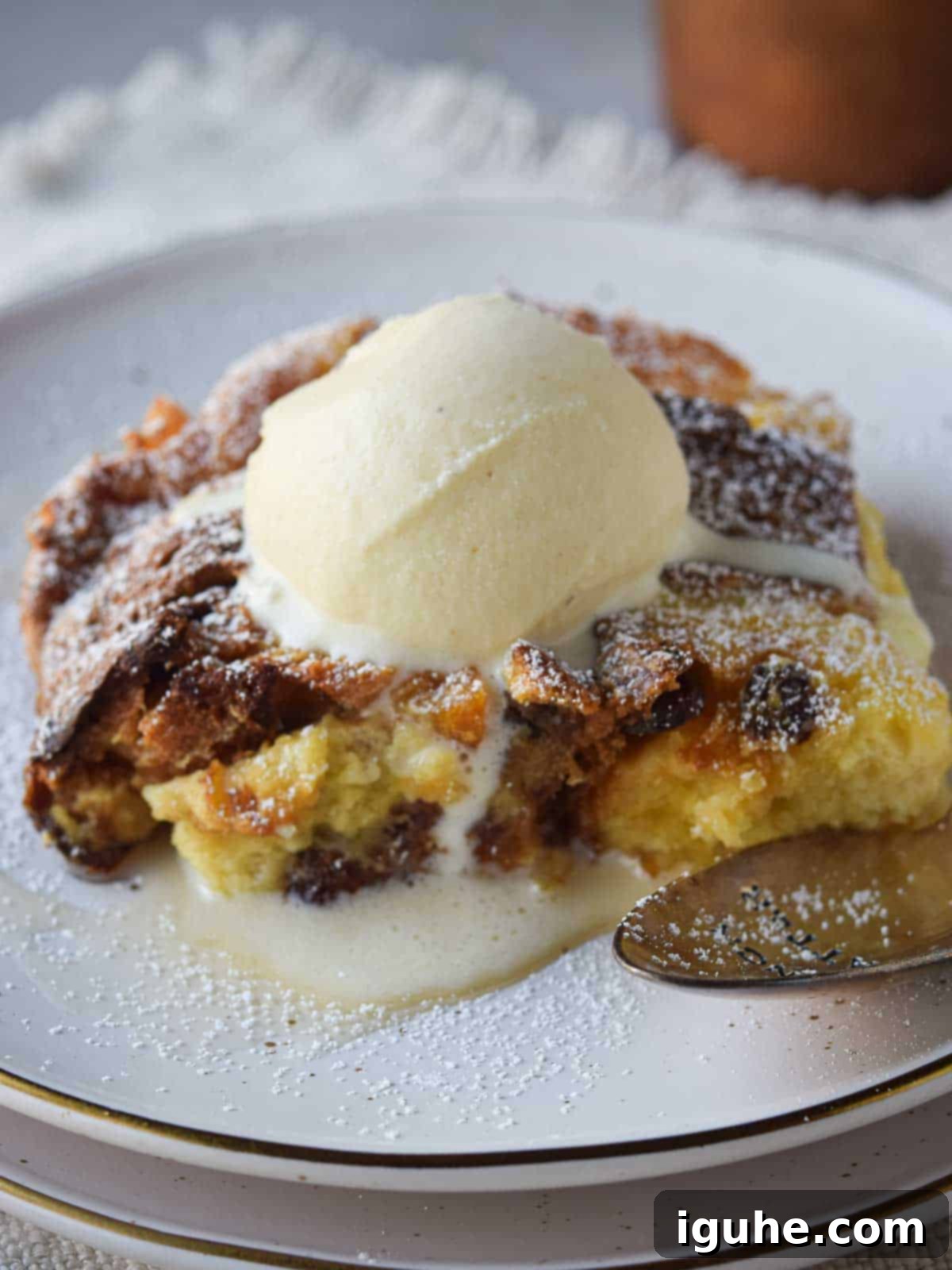
- Keep it Simple: Sometimes, less is more. A light dusting of powdered sugar adds a touch of elegant sweetness and a beautiful finish to the golden-brown crust.
- Classic Creaminess: A generous dollop of freshly whipped cream provides a cloud-like contrast to the rich pudding. You can even infuse the cream with a hint of vanilla or a dash of orange liqueur for extra flavor.
- Chocolate Indulgence: For chocolate lovers, a warm drizzle of homemade chocolate sauce or a high-quality store-bought option adds a luxurious, decadent layer that pairs wonderfully with the fruit and citrus notes of the panettone.
- A Scoop of Heaven: Serving warm bread pudding with a scoop of cold vanilla ice cream creates an exquisite hot-and-cold sensation that is simply divine. Consider other ice cream flavors like coffee, pistachio, or even this festive eggnog ice cream with crushed gingersnaps for a truly seasonal pairing.
- Breakfast Bliss: If you’re enjoying this as a special breakfast or brunch item, a generous pour of warm maple syrup transforms it into a comforting and hearty morning meal, especially delightful during chilly weather.
- Adult Pairings: For an after-dinner treat, serve alongside a robust cup of Italian espresso, a comforting tea, or an Italian liqueur such as Amaretto (with its sweet almond notes) or Frangelico (a rich hazelnut liqueur). These liqueurs complement the dessert beautifully and add a sophisticated touch.
- Fresh Fruit Finish: A scattering of fresh berries like raspberries or blueberries can add a pop of color, freshness, and a tart counterpoint to the pudding’s sweetness.
Storage and Shelf Life Tips for Panettone Bread Pudding
Ensuring your delicious panettone bread pudding stays fresh and flavorful for as long as possible is key, especially if you’re making it ahead of time or enjoying leftovers. Here are some essential storage tips:
Once your bread pudding has cooled completely to room temperature, wrap it tightly in plastic wrap or transfer it to an airtight container. Store it in the refrigerator for optimal freshness. When properly stored, it will maintain its delicious taste and texture for up to 5 days. For reheating, individual portions can be gently warmed in the microwave for 30-60 seconds, or you can reheat larger sections in a preheated oven at 300°F (150°C) for about 15-20 minutes until warmed through.
One of the most appealing aspects of panettone itself is its remarkably long shelf-life. An unopened panettone, thanks to its specialized packaging and rich ingredients, can last anywhere from 3 to 6 months, or even longer, when stored in a cool, dry pantry. This means you can confidently stock up on panettone during the holiday season sales, knowing you’ll have this versatile sweet bread on hand for future baking projects or impromptu treats throughout the year!
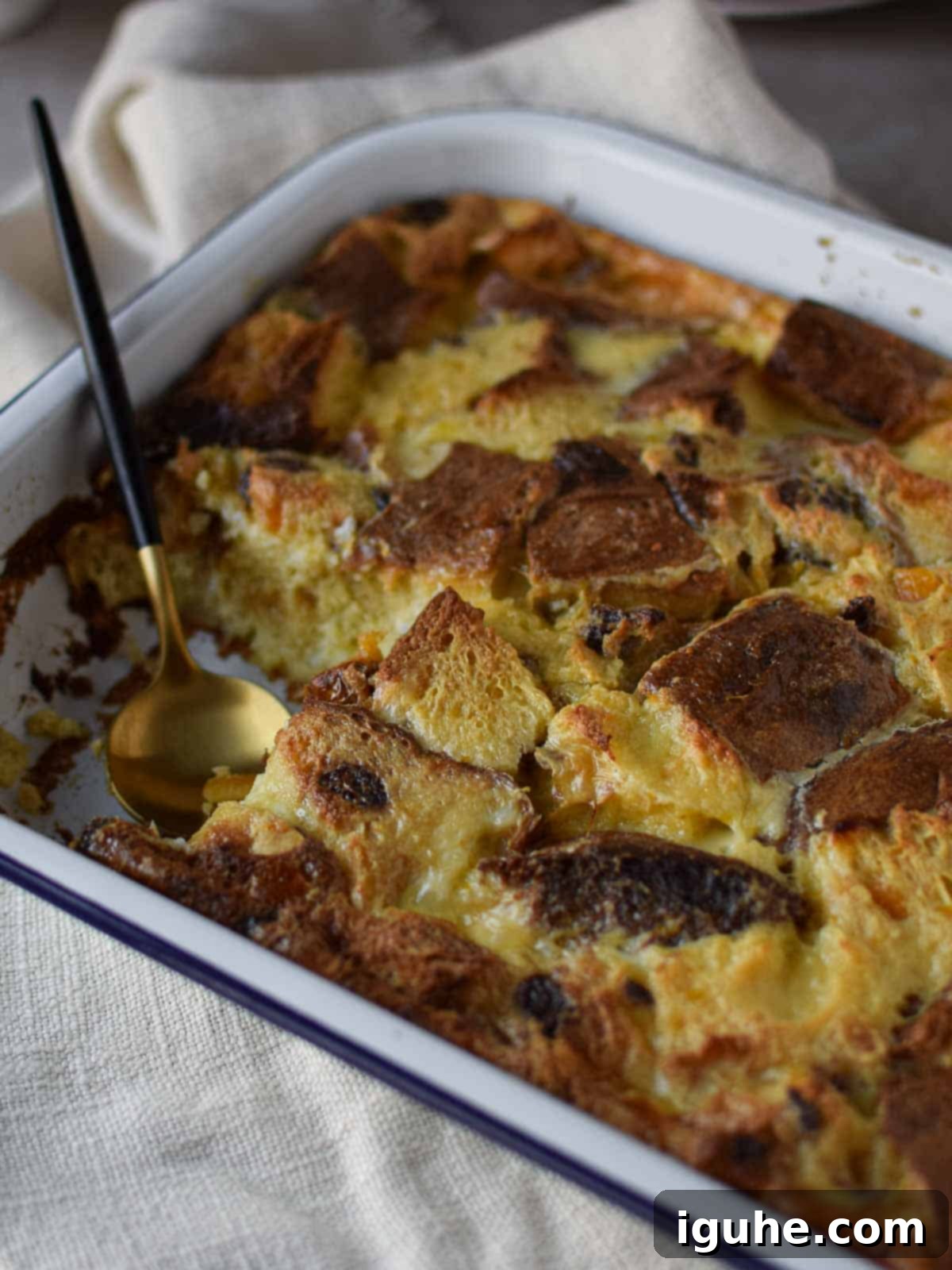
Frequently Asked Questions About Panettone
Curious about panettone? Here are some common questions and answers to deepen your appreciation for this beloved Italian sweet bread.
Panettone offers a truly unique sensory experience. Its golden crumb has a rich, buttery taste, often compared to a light brioche or a very tender sweet bread. The flavor is subtly sweet, balanced by bright hints of citrus, particularly orange and lemon zest, which are integral to its character. Depending on the variety, you’ll also encounter juicy raisins and soft candied fruits, adding bursts of sweetness and chewiness. The texture is delicate, incredibly light, and airy, almost cotton-like, making it melt in your mouth. High-quality panettone boasts a fragrant aroma, hinting at vanilla, citrus, and sometimes a faint touch of brandy.
Choosing a good panettone can make all the difference. For an authentic experience, look for brands that specify “Product of Italy” or “Made in Italy” to ensure you’re getting a quality product crafted with traditional methods. When you open the package, a strong, pleasant aroma should waft out—this is a great sign! You should distinctly smell the butter, vanilla, and especially the citrus. Visually, a good panettone has a tall, proud dome and a beautifully golden-brown crust. Internally, the crumb should be delicate, light, and airy, with visible strands when gently pulled apart. It should feel somewhat moist, not dry. Avoid panettones that feel dense, overly crumbly, or have an artificial smell, as these often indicate a lower quality or stale product. Don’t be afraid to try different brands and varieties to discover your personal favorite!
The cost of panettone can vary significantly. Most classic, mass-produced varieties found in grocery stores are relatively inexpensive, typically averaging between $7 and $12 for a one-pound loaf, making them an accessible holiday treat. However, artisanal panettones, especially those from renowned Italian bakeries or specialty food shops, can be considerably more expensive. These premium versions often use higher quality ingredients, undergo longer, more labor-intensive preparation processes, and may feature gourmet flavors or elaborate fillings. Consequently, these artisanal panettones can easily cost upwards of $30 to $50 or even more, reflecting their craftsmanship and superior quality.
More Italian-Inspired Delights to Explore
If you loved this Italian Panettone Bread Pudding, you might also enjoy these other delightful Italian-inspired recipes:
- Burrata Caprese Salad with Peaches
- Refreshing Espresso Soda
- Espresso Coffee Panna Cotta
- Easy Italian Pignoli Cookies
Did you make this delightful recipe? We would absolutely love to hear about your experience! Please take a moment to leave a ⭐⭐⭐⭐⭐ rating and a comment right below the recipe card to share your thoughts. If you captured a photo of your beautiful creation, don’t forget to tag us on Instagram @brunchandbatter. Your feedback and photos truly make our day!
📖Recipe
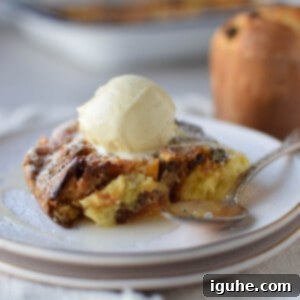
Italian Bread Pudding with Panettone
Pin Recipe
Equipment
-
1 9×13 baking dish
Ingredients
- 1 1lb Italian panettone, cut into 1-1.5 inch cubes (crusts on) Some panettones are slightly more than 1 pound (17.6 ounces or 1lb 1.6 ounces). You can use the whole thing.
- 8 large eggs
- 1 cup sugar
- 3¼ cup half-and-half (or half milk and half heavy cream)
- 1½ teaspoon orange zest
- 2 tsp orange liqueur (such as Grand Marnier) optional
- ⅓ cup sliced almonds optional
- powdered sugar for dusting optional
- butter for greasing the pan
Instructions
-
In a baking pan or tray, lay the sliced panettone in a single layer, and let it get stale (at least 6 hours or up to overnight). Alternately, toast the panettone in a 350℉ oven for about 10 minutes. If you are short on time, you can skip this step.1 1lb Italian panettone, cut into 1-1.5 inch cubes (crusts on)
-
Preheat the oven to 350℉. Butter a 9×13 baking dish on the bottom and up the sides.butter for greasing the pan
-
In a large bowl, whisk together the eggs and sugar. Add the milk, cream, orange zest and orange liqueur if using. Whisk until well blended.8 large eggs, 1 cup sugar, 3¼ cup half-and-half, 1½ teaspoon orange zest
-
Place the panettone in the buttered pan and spread evenly. Pour the egg mixture over the panettone. Gently press down on the cubes to submerge. Let stand for about 10 minutes.
-
Bake for about 45-55 minutes, until the top is golden brown and the middle is set. (It will puff up a bit and then deflate once it starts to cool). Serve warm, cold, or at room temperature with ice cream or whipped cream. It can also be eaten for breakfast!2 teaspoon orange liqueur (such as Grand Marnier), ⅓ cup sliced almonds, powdered sugar for dusting
Notes
For best results, store leftover bread pudding in an airtight container, or wrapped in aluminum foil in the refrigerator for up to 5 days.
Nutrition*
*Nutrition information is provided as a courtesy and is an estimate only. Nutrition information can vary depending on many factors, such as products used, measurements and substitutions, therefore it is recommended that you obtain nutritional calculations based on your own finished recipe.
